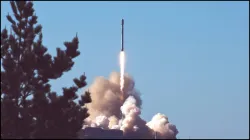India has more nuclear weapons than Pakistan, China records surge in stockpile: Report
India has developed eight new nuclear warheads in the past year, raising its stockpile from 164 to 172 in 2024, two more than Pakistan. Additionally, China has developed 90 new weapons from last year to 500 warheads, and its nuclear stockpile is expected to continue rising in the coming years.

Stockholm: India has overtaken Pakistan in the global race to develop nuclear weapons for the first time, as several countries have ramped up their arsenal as tensions rise across the world. According to a report by the Stockholm International Peace Research Institute (SIPRI), India now has 172 nuclear-armed weapons in 2024, more than Pakistan, which has 170 warheads.
India has developed eight new nuclear-armed weapon systems in the past year, raising its arsenal from 164 in 2023 to 172 this year. On the other hand, Pakistan's numbers have remained the same as last year. The SIPRI report confirms that all nine nuclear-armed countries - the United States, Russia, the United Kingdom, France, China, India, Pakistan, North Korea and Israel - have continued to modernise their nuclear arsenals and deployed new weapon systems.
China's nuclear stockpile has increased from 410 last year to 500 in 2024 and it has a total of 476 stored warheads. North Korea has 50 nuclear weapons, and increase of 20 from 2023, and Israel has 90 warheads, as per the report. The United States and Russia possess 90 per cent of all nuclear weapons. Washington has an inventory of 5,044 weapons, while Russia has 5,580. Russia is estimated to have deployed around 36 more warheads with operational forces than in January 2023.
India's nuclear development
The report noted that India's nuclear arsenal, whose only credible use till the 2010s was to deter Pakistan, has now started developing longer-ranger missiles capable of targeting all of China, expanding its scope of deterrence. While India has adhered to a nuclear no-first-use (NFU) policy since 1999, this pledge was qualified by a 2003 caveat (reaffirmed in 2018) that India could also use nuclear forces to retaliate against attacks by non-nuclear weapons of mass-destruction.
SIPRI estimates that India had around 80 operational missiles as of January 2024. At least three new land-based ballistic missiles were in development: the medium-range Agni-P and the intermediate-range Agni-V were nearing operational deployment, while a variant with intercontinental range, the intercontinental Agni-VI, was in the design stage. India is also developing a land-based version of the K-15 submarine-launched ballistic missile known as the Shaurya.
India has continued to develop the naval component of its nascent nuclear triad and to build a fleet of four to six ballistic missile submarines (SSBNs). INS Arihant was launched in 2018 as India's first 'deterrence patrol' and INS Arighat was launched in November 2017, and its deployment is expected sometime in 2024. At least two additional Arihant-class submarines are planned for deployment.
What does the data indicate?
According to SIPRI, India, Pakistan and North Korea are currently pursuing the capability to deploy multiple warheads on ballistic missiles, something Russia, France, the UK, the USA and—more recently—China already have. This would enable a rapid potential increase in deployed warheads, as well as the possibility for nuclear-armed countries to threaten the destruction of significantly more targets.
‘While the global total of nuclear warheads continues to fall as cold war-era weapons are gradually dismantled, regrettably we continue to see year-on-year increases in the number of operational nuclear warheads,’ said SIPRI Director Dan Smith. ‘This trend seems likely to continue and probably accelerate in the coming years and is extremely concerning.’
In addition to their military stockpiles, Russia and the USA each hold more than 1,200 warheads previously retired from military service, which they are gradually dismantling. Transparency regarding nuclear forces has declined in both countries in the wake of Russia’s full-scale invasion of Ukraine in February 2022, and debates around nuclear-sharing arrangements have increased in saliency, the report mentioned.
The total number of nuclear weapons in these nine countries has now risen to 12,121, out of which 9,585 are part of military stockpiles and 3,904 have been deployed atop ballistic missiles and aircrafts. Around 2,100 of the deployed warheads were kept in a state of high operational alert on ballistic missiles.
China's nuclear stockpile rises
China has developed as many as 90 new nuclear weapons, and the SIPRI report mentions that Beijing is believed to have some warheads on high operational alert for the first time. Its nuclear stockpile is expected to continue growing over the coming decade and some projections suggest that China could potentially deploy at least as many intercontinental ballistic missiles as either Russia or the US in that period.
Although the Chinese nuclear stockpile is projected to continue growing over the coming decade and the number of Chinese intercontinental ballistic missiles (ICBMs) is likely to reach or even exceed the numbers held by either the Russian Federation or the United States, China’s overall nuclear warhead stockpile is still expected to remain smaller than those states’ stockpiles, the report says.
The Chinese government’s declared aim is to maintain China’s nuclear capabilities at the minimum level required to safeguard national security,
with the goal of "deterring other countries from using or threatening to use nuclear weapons against China". The dramatic changes in China's nuclear posture, especially its deployment of quick-launch solid-fuelled missiles in silos have triggered widespread discussions about long-standing elements of Chinese nuclear doctrine, including its state 'no-first-use' policy. Washington believes that China is aiming to develop 1,000 nuclear warheads by 2030.
ALSO READ | Pakistan doesn’t have 'No First Use' policy on nuclear weapons, says top ex-Army official
ALSO READ | Iran increases enriched uranium stockpile to near weapons-grade limits amid stalled nuclear talks: UN report